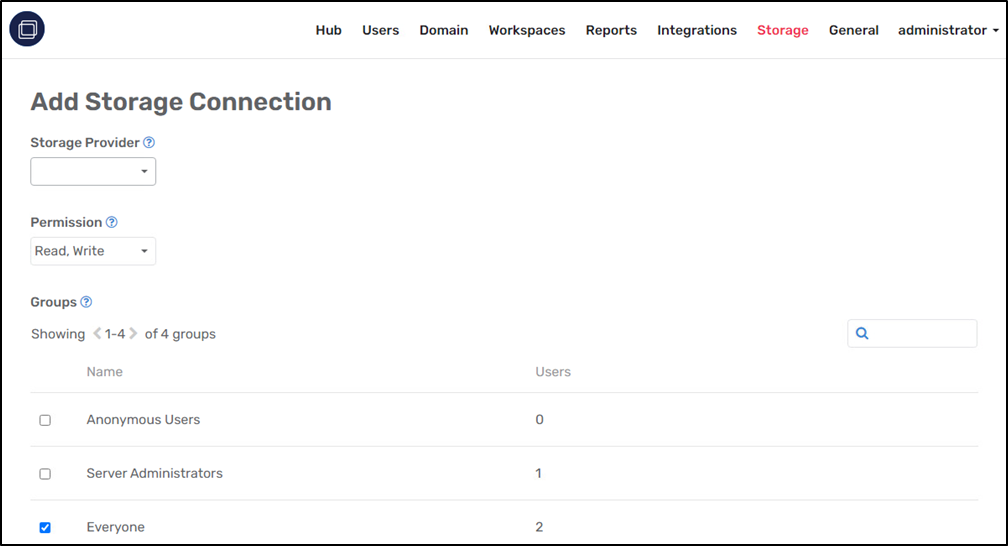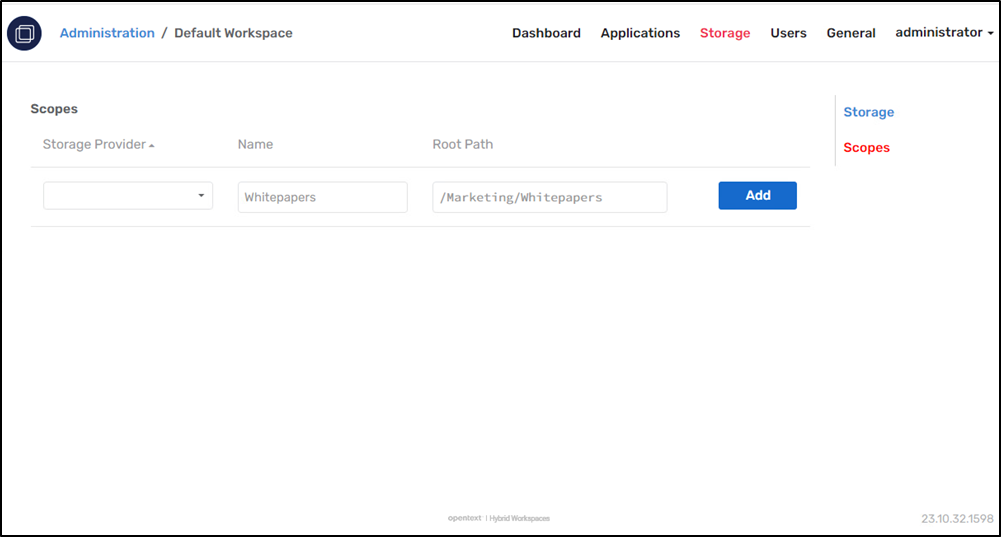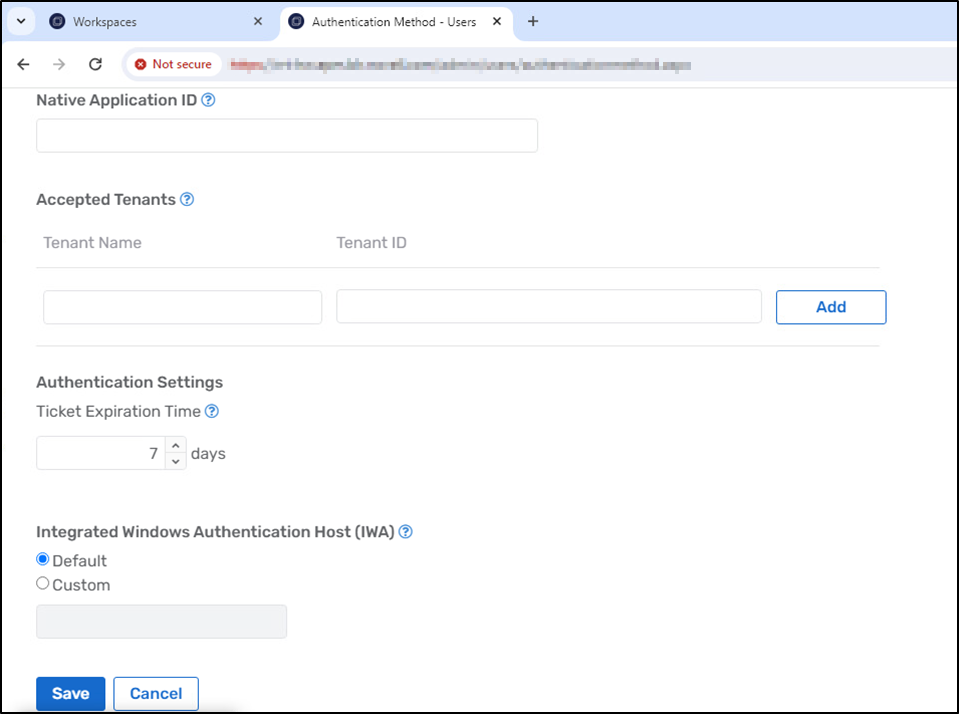Hybrid Workspaces 23.11 Readme
The information in this Readme pertains to Hybrid Workspaces Application Streaming and Packaging. Customizing applications to a virtual package and then delivering through application streaming on any platform with an HTML5 browser or even locally on a Windows OS device.
The following information is included in this Readme:
1.0 What’s New in Version 23.11
Hybrid Workspaces 23.11 includes the following updates:
Important note on the name change: Effective October 2022, the application's name is changed from Micro Focus Desktop Containers to Hybrid Workspaces.
1.1 Hybrid Workspaces - Application Streaming Server
This release includes several major features:
-
New! Storage Connections can now be created globally by administrators and made available to select user groups, allowing users to access shared files with no additional setup.

-
New! Workspace Storage Scopes create customizable, per-workspace views into storage provider connections.

-
New! Accepted Tenants restricts multi-tenant single sign-on (SSO) to a fixed set of tenants.

Other new features include:
-
External Database Connections allows servers from different cloud infrastructures or different tenants within the same cloud infrastructure to join a Turbo Server Domain
-
Concurrent Session Limit setting restricts the number of remote sessions that a user can run concurrently
-
Support Link setting that is displayed to users on error pages
-
New Turbo Server CLI command `admin domain-federation sync` triggers an on-demand domain federation synchronization
-
Check for Updates setting determines when application update checks are performed
Other improvements include:
-
The HTML5 Client copy & paste experience has been redesigned to provide a more seamless and intuitive experience
-
The HTML5 Client key states such as Num Lock are now synchronized on launch
-
Improved HTML5 Client error messaging for certain application launch failures
-
Web Application management has moved to the Server administration site under Hub. Configured web applications can be added to workspaces from the workspace administration site.
-
The Hub Images table now includes a Repository column instead of the Source column
-
Deleting a repository now deletes all associated workspace applications.
-
Turbo Server users are now considered Inactive when they are created through the administration site or federation. Inactive users do not consume user licenses until they login. Additionally, application launches will no longer be denied for users exceeding the Turbo Server license limits.
-
The Ticket Expiration Time and API Rate Limit inputs will now show the default value
-
Improved the Server Status display to more accurately reflect the state of provisioning servers
-
Dashboard Tabs settings have been expanded to further customize Portal dashboard tab visibility and default tab access
-
Improved performance of the Add Host Application dialog
-
Workspace applications are now created with isolation settings set to Inherit from Workspace
-
Applications launched from the Portal now immediately check for application updates if a new image has been pushed to the Hub
-
Improved the application server profile pool allocation strategy to be more performant during periods of high launch volume
-
Images pushed from Turbo Studio or the Turbo Client no longer set the icon padding or background color by default
-
Apache Proxy logs are now located in the installation path Logs folder and rotate based on date and size
-
The Turbo Server installer now provides the option for users to proceed even if the verification of the database connection fails
-
The Turbo Server installer now requires at least one role to be selected and provides additional information if a role is not available
-
Various minor text and visual improvements
This update includes fixes for the following issues:
-
Turbo Drive filesystem mounts could encounter errors performing certain folder operations, such as creating and renaming new folders or deleting and recreating non-empty folders
-
Turbo Drive overwrite and set file size operations incorrectly reported portions of the resulting file metadata, causing application errors in rare circumstances
-
The OneDrive Test button failed for multi-tenant configurations
-
The User Groups table item count was not accurate under certain circumstances
-
The Server diagnostics uptime did not display correctly for large values
-
The Advanced Testing page Auto server assignment option did not correctly distribute loads according to the resource allocation strategy
-
The Turbo Virtual Machine repository incorrectly reported federation settings
-
The Portal Files API leaked file handles under certain circumstances, leading to Portal errors over prolonged periods
-
The Turbo Server installer showed incorrect validation errors when navigating back and forth between pages
-
The Turbo Server command-line installer incorrectly installed as x86
-
Images pushed from Turbo Studio or the Turbo Client did not properly display an icon if the image only contained icons in ICO format
This update includes the following dependency updates:
-
Turbo Client has been updated to 23.10.12
-
Turbo VM has been updated to 23.9.13
1.2 Hybrid Workspaces - Studio (Application Packaging Tool)
This update to Turbo Studio includes the following improvements and bug fixes:
-
The Turbo VM is updated to version 23.12.1
-
Add support for AppLocker on Windows 11
-
Add support for Capture of shortcut working directories
-
Fix crash on startup for some applications when using DLL injection
-
Fix FindFirstFile/FindNextFile Windows API to return results in the correct order
-
Fix CreateProcess Windows API to have correct return code when process initialization failed for DLL injection
-
Fix Truncate Logs feature in the Debugger
-
Fix slow log reload when creating comparisons in Debugger
-
Fix title bar does not indicate that changes have been made when editing startup files
-
Fix manifest dependency resolution when using wildcard architecture
-
Update XStudio /capture command to query for whether the capture is started
-
Update Desktop panel dialogs
-
Update ProgId Verbs to have explicit target path and parameters
-
Add support for capture of Microsoft Office 365
-
Add support for Windows 11-specific layers
-
Add support for exporting only XAPPL configuration from very large images
-
Fix evaluation of NotEqual layer conditions
-
Fix system tray icons in Citrix environments
-
Fix potential deadlock from calls to NtSuspendProcess
-
Fix Microsoft Office 365 Outlook repair error on first launch
-
Fix Chromium Sandbox applications when using network image cache
-
Fix application manifest load errors when using DLL Injection
-
Fix NtSetInformationKey with merge isolated registry keys that don't exist natively
-
Fix NtQueryAttributesFile for OneDrive mapped drives
-
Fix "Unable to start restart manager session" error during Capture
-
Fix wildcard matching for entries in Snapshot Settings file
-
Fix unnecessary rebuild of SVM when publishing to Turbo Server
-
Fix publishing application icon to Turbo Server
-
Fix ProgIDs and File Extensions being skipped during Capture
-
Fix Capture of shortcuts with URL targets
-
Fix Capture of some shortcut icons
-
Fix invalid SVM when startup files have empty paths
-
Fix building of Portable Executable project types
-
Fix loading assemblies from network image cache
-
Fix Layer Condition editor default values
-
Fix Build & Run container status dialog
-
Fix Debugger open container dialog
-
Improve speed of Configuration saves
-
Improve dynamic resolution for Microsoft Visual C++ Redistributable (vcredist)
-
Update file cache path to %TEMP%\Turbo\Cache
-
Update registry sandbox path to HKEY_CURRENT_USER\Sofware\Turbo\SandboxCache
2.0 Known Issues
This section contains information about issues that might occur while you work with this release:
2.1 Do not upgrade to Hybrid Workspaces version 23.11 if using ZAM integration
The following ZAM integration error is displayed when you try to upgrade to Hybrid Workspaces version 23.11 if using ZAM integration:
System.Net.WebException: The remote server returned an error: (403) Forbidden. at System.Net.HttpWebRequest.GetResponse()
Do not upgrade to Hybrid Workspaces version 23.11 irrespective of the Hybrid Workspaces version you use.
3.0 Product Documentation
The following sources provide information about Hybrid Workspaces:
4.0 Understanding the Upgrade Requirements
-
All application configuration documents and application certificates created with ZENworks Application Virtualization 8.x, 9.x, 10.x, and 11.x must be re-created in order for application streams to work with the Hybrid Workspaces standalone components.
To generate a new certificate and regenerate the configuration files:
-
In the Advanced section of the Hybrid Workspaces Studio, click the App Config button to regenerate the application stream configuration files.
-
To generate a new site license certificate, click Advanced.
-
In the Application Certificates dialog box, click Request Certificate.
-
Specify the following information in the fields:
-
Organization: The organization name.
-
Unit: The user or unit name.
-
Allowed Portal Hosts: The allowed host names of the servers from which the application will stream.
-
-
Click Request to request the site license certificate, then save the certificate to a desired location.
-
Click the App Config button to regenerate the application stream configuration files again.
-
-
ZENworks Application Virtualization (ZAV) versions, Micro Focus Desktop Containers (MFDC) versions, and Hybrid Workspace versions always run side by side on a device. Running older versions (ZAV or MFDC) do not change in any way when running in a Hybrid Workspaces environment.
However, if you open a package built with ZAV or MFDC version of Studio, using the latest Hybrid Workspaces Studio, saving it automatically upgrades the package to the latest HW Studio Packager version and the older packaged version becomes obsolete and should be decommissioned.
5.0 Legal Notices
For information about legal notices, trademarks, disclaimers, warranties, export and other use restrictions, U.S. Government rights, patent policy, and FIPS compliance, see .
© Copyright 2008 - 2024 Open Text
The only warranties for products and services of Open Text and its affiliates and licensors (“Open Text”) are as may be set forth in the express warranty statements accompanying such products and services. Nothing herein should be construed as constituting an additional warranty. Open Text shall not be liable for technical or editorial errors or omissions contained herein. The information contained herein is subject to change without notice.